

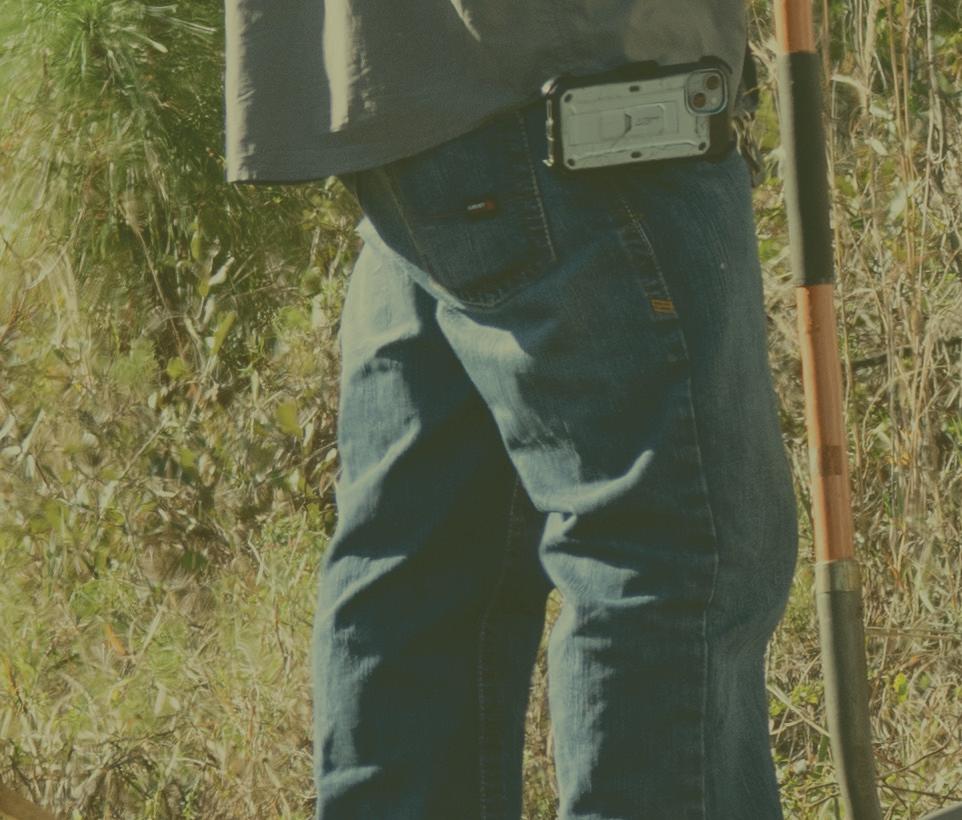



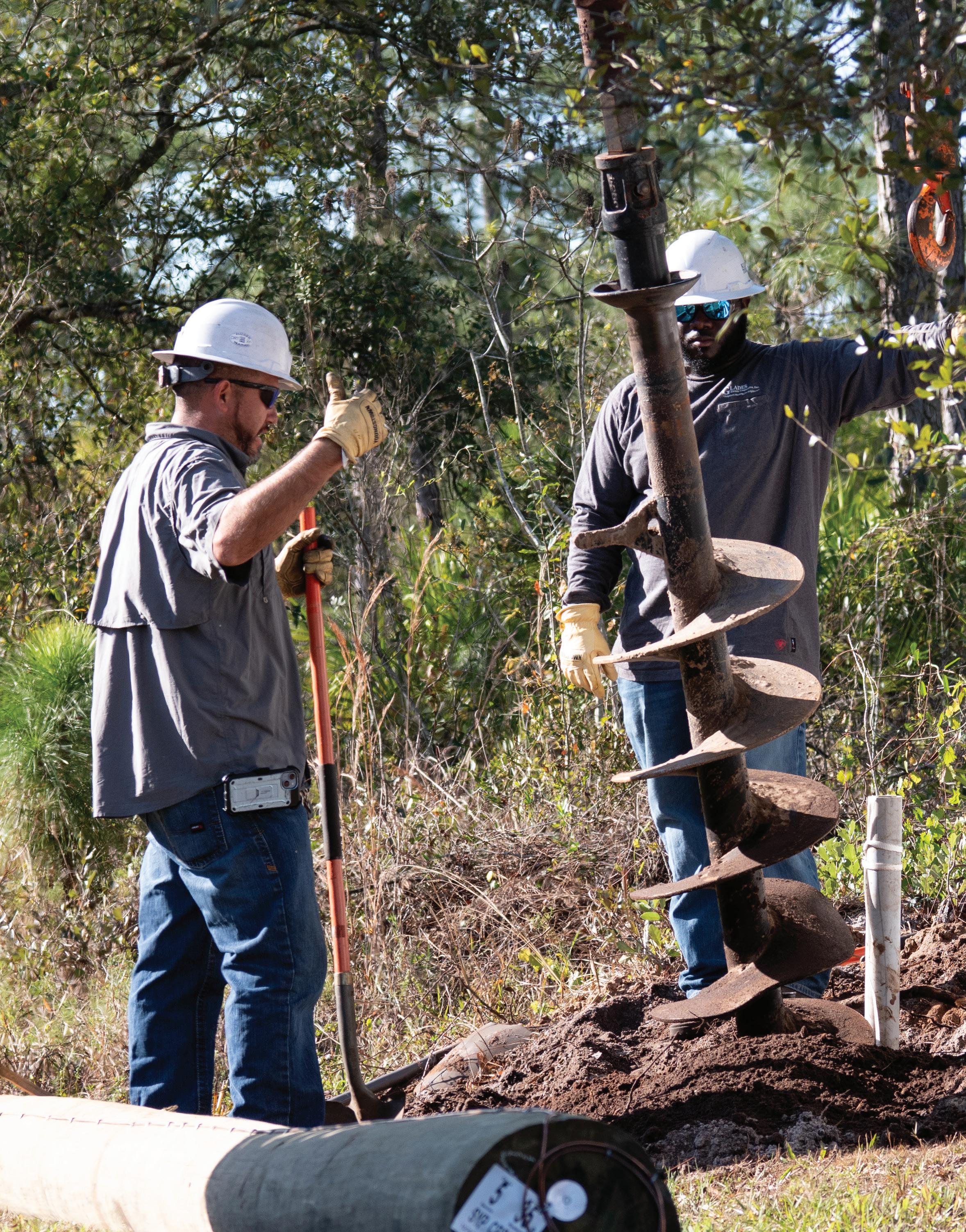


















































































CEO Michael Shepard
VICE PRESIDENT OF CONTENT Leon Espinoza
EDITORIAL DIRECTOR Chasity Anderson, CCC
DEPUTY EDITORIAL DIRECTOR
Noble Sprayberry
SENIOR EDITOR Jennifer Paton, CCC
FLORIDA CURRENTS EDITORS
Valeri Saldanha Rosa; Sable Riley, CCC
ASSISTANT EDITORS Victoria Hampton, CCC; David Herder, CCC
ASSOCIATE EDITOR
Nina Todea
PUBLICATIONS PRODUCTION
SENIOR MANAGER
Elizabeth Beatty
SENIOR PUBLICATIONS COORDINATOR
Alyssa McDougle
Members acknowledge that $4.49 a year, plus postage, is the cost to publish 12 issues a year of FLORIDA CURRENTS ISSN 23276304 (USPS 8300). Published by Pioneer Utility Resources Inc., 5625 NE Elam Young Pkwy. Ste. 100, Hillsboro, OR 97124—a not-for-profit Oregon cooperative corporation—the magazine serves the communication needs of consumerowned electric utilities in Florida. Preferred Periodicals postage paid at Hillsboro, OR 97123 and at additional mailing offices.
Postmaster: Send address changes to 5625 NE Elam Young Pkwy., Ste. 100, Hillsboro, OR 97124-6422.
HOW TO CONTACT FLORIDA CURRENTS
Subscription services:
Nonmember subscriptions $15 U.S. a year; $25 foreign a year. Prepayment required. Allow 4-8 weeks for first issue. Identify local edition desired. Have a problem receiving your magazine? Utility members should contact their utility office. Nonmembers call 503-357-2105 or email mailingdept@pioneer.coop. Back issues:
Back issues and extra copies are $3 each, prepayment required. Supply is limited. Identify edition, month and year. Call first to check availability. Contact Pioneer Utility Resources: P.O. Box 1306, North Plains, OR 97133-1306; 503-357-2105; email: mailingdept@pioneer.coop.
DISPLAY ADVERTISING INQUIRIES
American MainStreet Publications 611 S. Congress Ave. Ste. 504 Austin, TX 78704-1714; 800-626-1181 or 512-441-5200; amp.coop.
© 2025 Pioneer Utility Resources. All rights reserved. Reproduction in whole or in part without written permission is prohibited. Direct reprint requests to editor@floridacurrents.com or for more information, visit www.pioneer.coop.
April 2025 • Volume 14, No. 6 For additional content, search @FloridaCurrents on your favorite social media sites and floridacurrents.com.



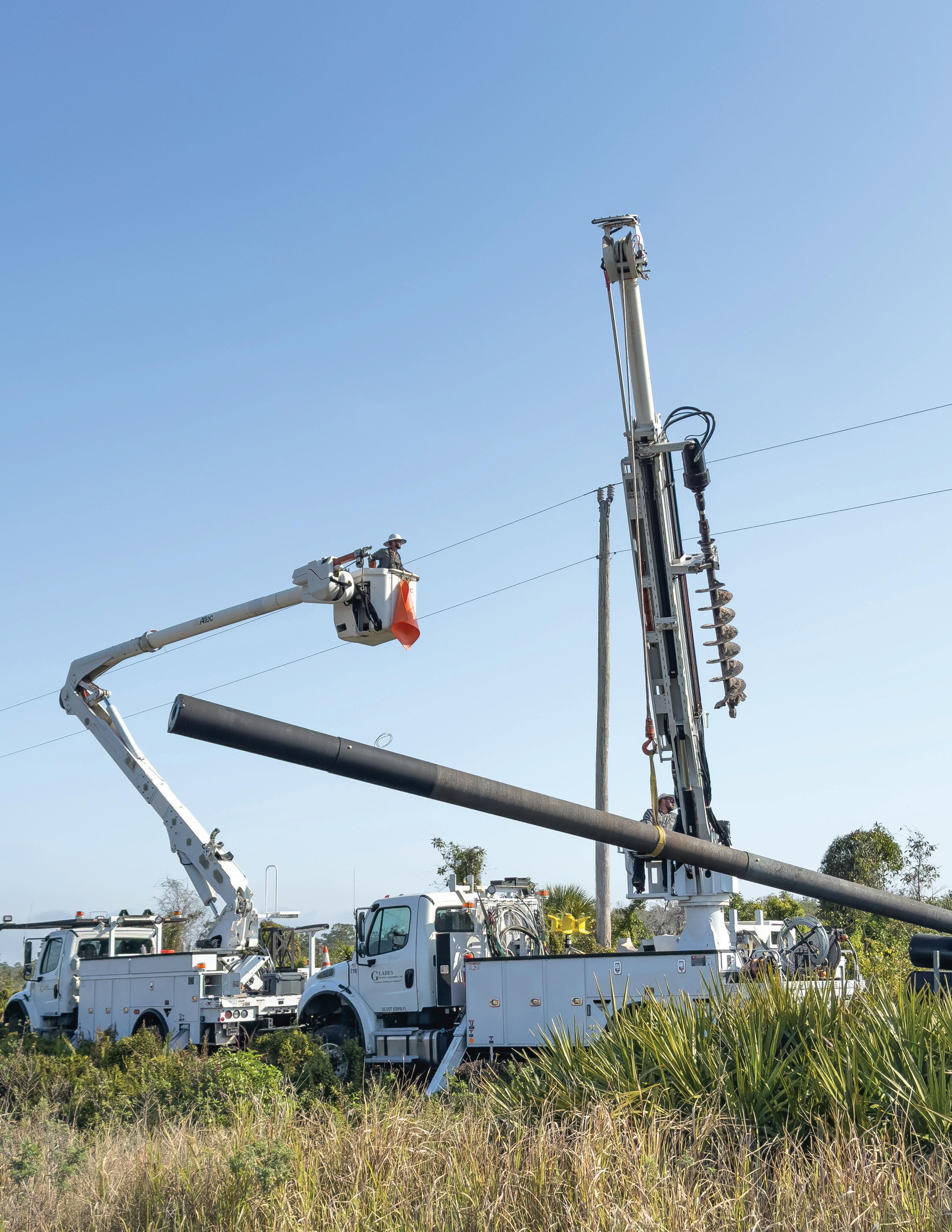


In the quiet hours before dawn breaks, lineworkers begin their day often clad in flame-resistant clothing, safety goggles, rubber gloves and heavy boots. They epitomize dedication to service in its purest form. In celebration of Lineworker Appreciation Day on April 14, Glades Electric Cooperative reflects on the essential role they play in members’ daily lives.
Amid towering utility poles and power lines, lineworkers exhibit a strength that goes far beyond the physical. Whether battling inclement weather, troubleshooting technical problems or navigating treacherous heights, lineworkers demonstrate resilience and a quiet determination to keep lights on, homes comfortable and communities connected.
Glades Electric crews travel across a four-county service territory as they build, maintain and repair parts of the local system. Their extraordinary skills ensure homes remain connected to the grid, businesses stay operational and







emergency services remain accessible—a lifeline that connects everyone.
In moments of crisis, when the lights go out and members find themselves in the dark, lineworkers emerge as beacons of hope. Their swift response restores normalcy, offering reassurance in times of uncertainty. Whether repairing stormravaged power lines or ensuring continuity during emergencies, their unwavering commitment illuminates life when it’s needed most.
Glades Electric’s lineworkers also answer the call beyond the boundaries of home. Crews travel to fellow co-ops—near and far—when widespread outages occur and additional support is needed. Cooperation Among Cooperatives is one of GEC’s seven guiding principles, and our lineworkers embody this core commitment.
This month, while celebrating the remarkable men and women who ensure reliable power, let’s recognize their unwavering dedication to the local communities they serve.
The next time you flip a switch, please take a moment to remember those who make it possible—lineworkers, who are wired for service and dedicated to illuminating life.



OPPOSITE PAGE: Wyatt (in bucket) and Lead Lineman David Rice prepare to replace an older wooden pole with a ductile iron pole in Cornwell.
PHOTOS BY
JENNIFER KOUKOS




By Abby Berry
Electric cooperatives stand out from other types of businesses because they are built and led by the communities they serve.


As an independent, not-for-profit electric utility, Glades Electric Cooperative is owned and governed by its local members—not by outside shareholders or investors. That is a powerful differentiator. Here are a few ways electric co-ops like Glades Electric Cooperative bring unique value to the communities they serve:
• They put people before profits. Co-ops are not-for-profit and provide at-cost service. Any excess revenue is returned to consumer-members in the form of capital credits, typically distributed as bill credits or via checks.
• Community comes first. Glades Electric employees live and work here and care deeply about their communities. That’s why the co-op engages in development and revitalization projects; sponsors students for scholarships and programs; and gives back to local organizations such as school athletic programs, Nu-Hope Elder Care Services, Habitat for Humanity, Ridge ARC, the Education Foundation of Okeechobee, and the United Way to help neighbors in need.
• Affordable, reliable power is the cooperatives’ priority. Glades Electric purchases electricity from wholesale energy partner Seminole Electric Cooperative. Seminole Electric is a




generation and transmission cooperative formed by a group of Florida electric co-ops. This business structure allows cooperatives to pool local resources and provide electricity at a lower cost than if they purchased it from outside sources.




Glades Electric is focused on members’ energy needs—not only for today but for the long haul. GEC advocates for smarter energy policies that prioritize reliability and affordability for all, and it recognizes it must be inclusive of all energy sources, which is why Glades Electric works closely with Seminole Electric to ensure use of a diverse mix of sources—such as coal, natural gas and solar— to generate the electricity provided to members.
Glades Electric Cooperative is working to power a brighter future through innovation that meets tomorrow’s energy needs. GEC has partnered with Conexon Connect to bring world-class, high-speed fiber internet service to all co-op members and is implementing a distribution automation project this year using a new fiber communications system to improve reliability, reduce the number of members affected by outages and enable faster response times.
Reliable, affordable electricity is more important than ever before, and the cooperative’s focus will continue to be the best interest of its communities.
To learn more about Glades Electric Cooperative, visit gladeselectric.com.


















Thanks to the generosity of Glades Electric Cooperative members who participate in Operation Round Up, a $3,750 grant has been awarded to the United Way of Lee, Hendry and Glades. These funds help expand the School Resource Center initiative to provide essential items to students in Glades and Hendry counties.
In January 2025, the Glades Electric Charitable Trust board approved the grant to support this expansion, ensuring local students have access to clothing, school supplies and hygiene products. The School Resource Center is a collaborative effort between the United Way and local school districts, working to meet students’ basic needs so they can focus on learning.
Through this initiative, students and their families work with school counselors, social workers and school resource officers to identify necessary items. Requests are then processed at the School Resource Center—located at the Lee County School District headquarters—where United Way staff and volunteers package the items and deliver them to schools. Delivery is typically within two business days.
The Glades Electric Charitable Trust reviews Operation Round Up grant applications from organizations and individuals every month. If you know of a need, applications are available at https:// www.gladeselectric.com/community/ operation-round-up/.
Not yet rounding up your electric bill? Consider joining Operation Round Up to make a meaningful impact in the community. By rounding your bill to the nearest dollar, your small donation can create big change for local families in need.
Sign up through SmartHub, scan the QR code to complete a short form or call our member services team at 855-940-3810.
At Glades Electric Cooperative, we believe in the power of community— because together, we are Neighbors Helping Neighbors.





Students are discreetly given their essential items, such as school supplies, clothing, jackets or shoes, in reused boxes for confidentiality and privacy. PHOTOS COURTESY OF UNITED WAY OF LEE,
privacy.




AND








What is it?
Operation Round Up is a program that allows members to round up their monthly bills to fund projects benefiting community members in need.
Nine members serve on the board of directors for Glades Electric Charitable Trust, a 501(c)(3) nonprofit organization. Directors review applications and approve grants.


6




How does it work?
$138 55 cents to your neighbor in need. The average yearly contribution is $6 per member.

Lorida District 7


Howard Lake Josephine District 8


$4,100.00 in Operation Round Up funds awarded in February 2025 to local nonprofits and members in need.

Funds from Operation Round Up go right back into the communities we serve.



44%
How can I help?
$4,148.21


Byars Okeechobee District 9 raised by Operation Round Up and Round Up Plus in January 2025.











Did you know?














8,247 accounts participate in Operation Round Up or Operation Round Up Plus. Round Up Plus allows members to give even more, adding any set amount, $1 or more, to their bills each month.




The participation rate it would take to raise more than $70,000 annually to support our communities. 75%
How can I get help?
Sign up for Operation Round Up in the SmartHub app or on your payment stub, stop by the office or call 855-940-3810.
If you or a member you know needs financial assistance, please complete an application at: www.gladeselectric.com/community/operation-round-up. $137.45 Amount due: Power Bill UP ROUND
Where engineering excellence meets sleek design - a lightweight, safe, customizable, and stylish scooter for UNLIMITED FREEDOM. Numerous scooters with various features and capabilities are on the market, making it crucial to select the one that best suits your requirements.







At the age of 56, a back operation left me dependent on a cane, significantly impacting my daily life. Simple tasks like going to the store or meeting friends became challenging, and I even had to cancel a long-awaited anniversary trip to Italy. My husband purchased a scooter for me, but it was cumbersome and uncomfortable for everyday use, leaving me feeling more constrained than liberated. However, everything changed when I came across the ATTO SPORT. This remarkable scooter proved to be a game changer. Not only is it robust and reliable, but it also conveniently splits into two pieces, allowing me to effortlessly lift it into my car trunk on my own. I was even able to stow it in the overhead compartment on the plane, enabling us to finally take that trip to Italy! I am now independent once more, able to go wherever I please and do so with a striking sense of style. In fact, I now find that my husband struggles to keep up with me!



Independence and convenience: Easy to use and conveniently folds into a compact suitcase size for simple storage. It easily separates into two parts in seconds, with the heaviest piece weighing just 37 pounds, making it easier to lift into your car trunk.

Go anywhere: Conquer any terrain with puncture-proof, shock-absorbing tires and a 4-inch ground clearance. Equipped with electronic stability control for added safety on descents and turns, it is also flight-approved, ideal for air travel and cruise ships. With a driving range of up to 12.5 miles (25 miles with the XL battery), a top speed of 6.2 MPH, and a maximum weight capacity of 300 pounds, this durable scooter is designed for longevity.
Top-Notch Engineering: Guaranteeing both comfort and durability, this scooter offers ample legroom and a big comfortable seat. The ATTO is super portable and lightweight, and still rides like a heavy-duty scooter.
Unmatched Stylish Design: You deserve a mobility solution that doesn't just get you from A to B but makes you feel great while doing so. ATTO stands out from the crowd with its stunning design.
Free home demos & test drives available nationwide
Showrooms or Demos: AZ, CA, CO, CT, FL, IL, MD, NJ, NV, NY, VA, OR, TX, WA



DON’T WAIT!
Call today and get a free front/rear basket and phone holder with your new ATTO SPORT purchase!
Airline approved. Spacious legroom, comfortable seat $184 value






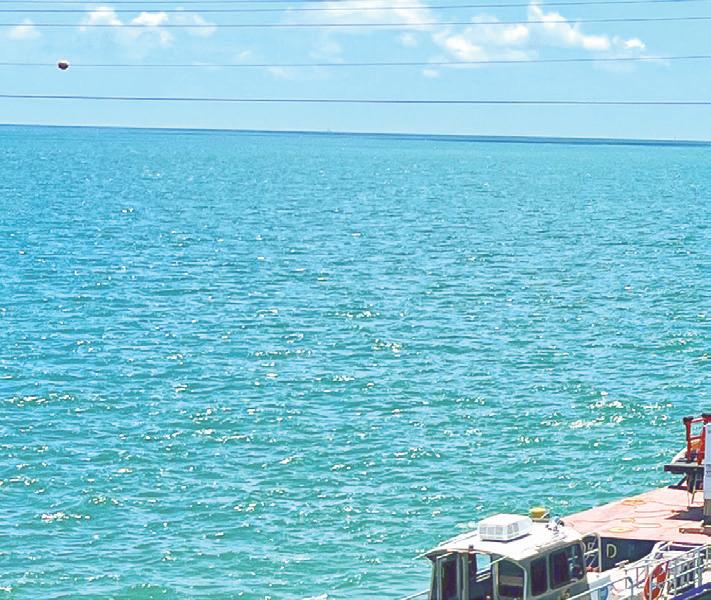




What does it take to become a lineworker?
By Jen Calhoun
Taylor Hammack was wiring houses for a living around the time Hurricane Michael made landfall along the Florida Panhandle in 2018. The Category 5 hurricane flattened homes and businesses, destroyed infrastructure and left at least one town along the Gulf Coast in ruins.

The ordeal sparked something in Taylor as he drove to work one day.
“It was about three or four days after Michael hit, and I saw all these line crews on the side of the road getting the power back up,” he says. “Just seeing them do that after something catastrophic had happened—I thought, ‘That’s what I want to do.’ To me, it was a way to help people when they’re in need.”
Soon after, Taylor was hired as an apprentice lineworker at Gulf Coast Electric Cooperative, which put him through a four-year training program with Tennessee Valley Public Power Association. Today, Taylor is a journeyman lineworker.
Lineworkers install, maintain and repair power lines and



equipment on utility poles and underground electrical systems. It’s a tough but rewarding trade that usually requires three to four years of training to achieve rank as a fully qualified journey-level lineworker. A few other qualities are important, too, say lineworkers across the country.

Since the first electric wire was strung, lineworkers have held an important role in modern America. When disaster strikes, they’re the ones who get the lights back on. They work along city streets, farmlands and wilderness.

The job can be difficult and sometimes dangerous, but the rewards are excellent, says Nick Hagen, a journeyman lineworker at Northern Lights Inc. in Idaho.
“I like the appreciation the community gives us, especially after we get the power back on after three days, four days or even 10 days,” he says. “It’s a fulfilling job.”




Nick remembers pulling up near a house to repair power lines one Christmas Eve.
“They had been out of power for days,” he says. “Once I finished, I remember seeing their Christmas lights come back on. I thought that was pretty cool.”
The pay is good, too, he says. Nick was making ends meet as a valet at a hotel when he first learned about the trade. He wanted a better life for his family, and linework fit the bill. It also gave him a chance at retirement.
“Getting a good job with a retirement where you could actually enjoy your life after work? Nobody had ever really talked about that to me,” he says.
While compensation and benefits vary for lineworkers depending on location, experience and other factors, the Occupational Outlook Handbook published by the U.S. Bureau of Labor Statistics reports the median pay in 2023 was $85,420 per year, or $41.07 per hour. However, those figures represent the middle of the pay range, and they don’t take into account overtime hours and additional jobs helping other utilities in the aftermath of storms—all of which can result in additional income.
Joining the trade means learning various—and oftentimes difficult—technical skill sets in and out of the classroom, all while maintaining a certain level of physical fitness, says David Bogue, a journeyman lineworker with Florida Keys Electric Cooperative.
Not only do lineworkers need to know how electrical systems work, they’re also required to learn numerous safety techniques. In addition, lineworkers climb utility poles wearing heavy toolbelts in all kinds of weather. The job requires working days and nights, depending on schedules and needs.
“Everybody’s story is a little bit different. Everyone gets into the trade in their own way.”
EVAN PETERS, LINEWORKER AT BENTON REA IN WASHINGTON
“I would say becoming a journeyman is an attainable goal, but it’s a hard goal,” David says. “But, as someone once told me, I could throw a dart at a map and go get a job there. Also, the skills I’ve learned are not going to be replaced with AI anytime soon.”
Lineworkers can get their start by attending training schools, taking community college courses or working at a local utility in other capacities, such as a groundworker. Rudy Vega, a journeyman lineworker at FKEC, got his start doing right-of-way work with the cooperative 23 years ago.
“I had been working in a tree group there just under two years when the opportunity came up to be an apprentice lineman,” Rudy says. “They approached me and asked me if I was interested, and I said, ‘Definitely. I’ll give it my best.’ ”
Evan Peters, a lineworker at Washington’s Benton Rural Electric Association, was fighting wildfires when he first learned about the trade from a group of lineworkers.
When he expressed an interest in the job, one of the men suggested he attend a lineworker school. After graduating, he took a job at Benton REA.
“I like that it’s something new every day,” Evan says. “I like that I get to work outside with my hands, especially at a local utility. It can be really fulfilling.”
When it comes to joining up, however, Evan suggests those interested ask around before they jump in headfirst.
“I would tell them to reach out to local linemen,” he says. “Ask them how they did it. Everybody’s story is a little bit different. Everyone gets into the trade in their own way.”
Must-haves:
Be 18 years of age.
Hold a high school diploma or GED.
Maintain a valid driver’s license.
Able to work at heights and lift heavy equipment.

Getting started?
Every lineworker has a story about how they got started, and there are many pathways to taking the job. Here are a few ways to make it happen:
Join an apprenticeship program at a local utility.
Enroll in a lineworker school or training program.
Start at a utility as a groundworker or other job.

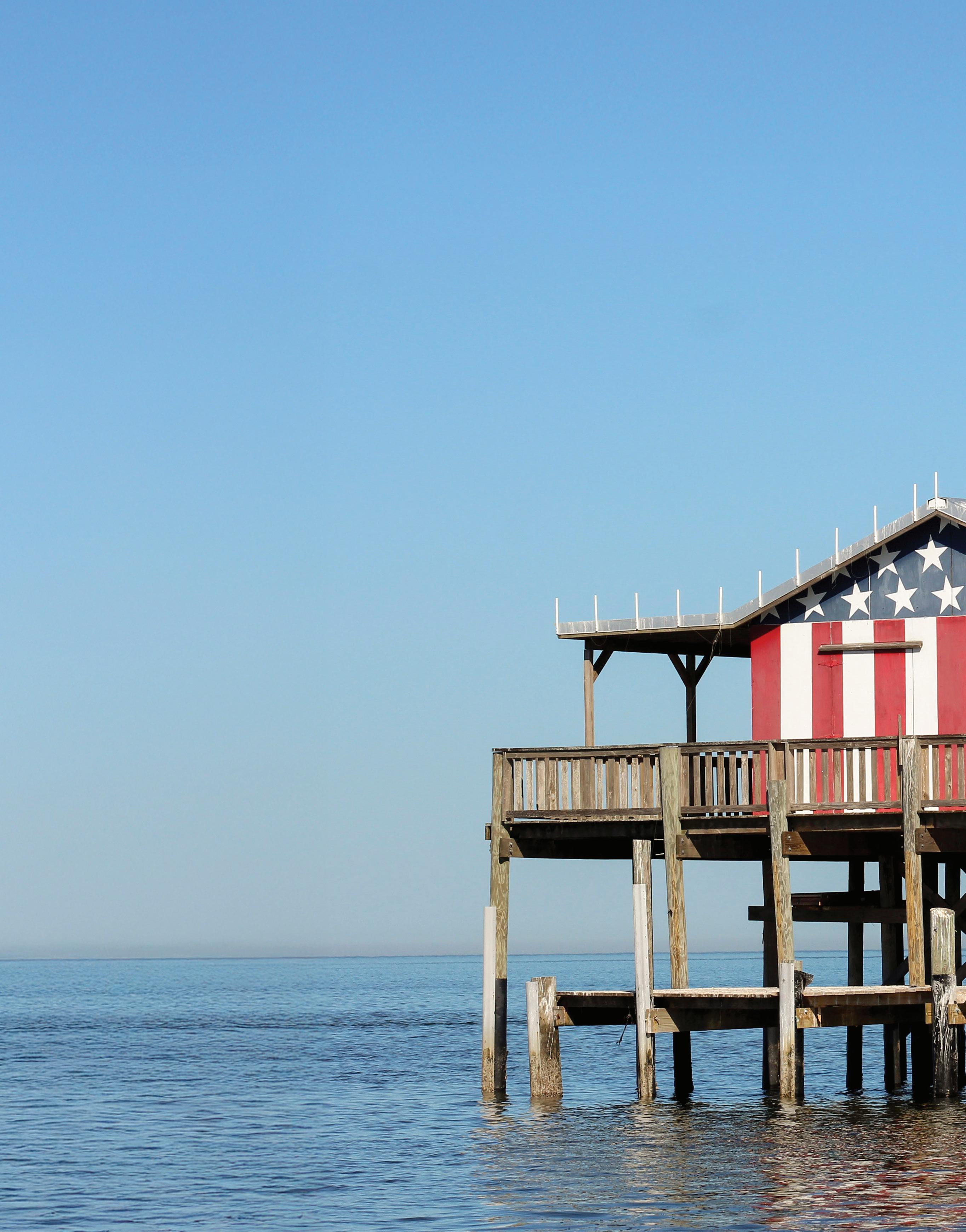
By Cheré Coen



The sun warmed our faces on the Gulf waters as Capt. Mark Dillinghan puttered us down the Pithlachascotee River—what locals in Pasco County call the Cotee. Mark leads fishing charters through his Inshore Adventures, but on this morning, we set out to fish for history.
We gingerly motored the river past both modest homes and luxurious estates, and Port Richey seafood restaurants. Beneath our boat, manatees escaped winter’s chill. As the river widened, mangroves appeared—some providing nesting areas for pelicans and perches for cormorants.
At the river’s mouth, one of the most unique sights in Florida emerged—the stilt houses of Pasco County.
These rugged buildings were established in the early years of the 20th century, when commercial fishermen pulled in mullet. The fish were transported using boats propelled by poles, so having a spot to store a haul for several days proved useful. The structures also served as refuge from sudden thunderstorms.
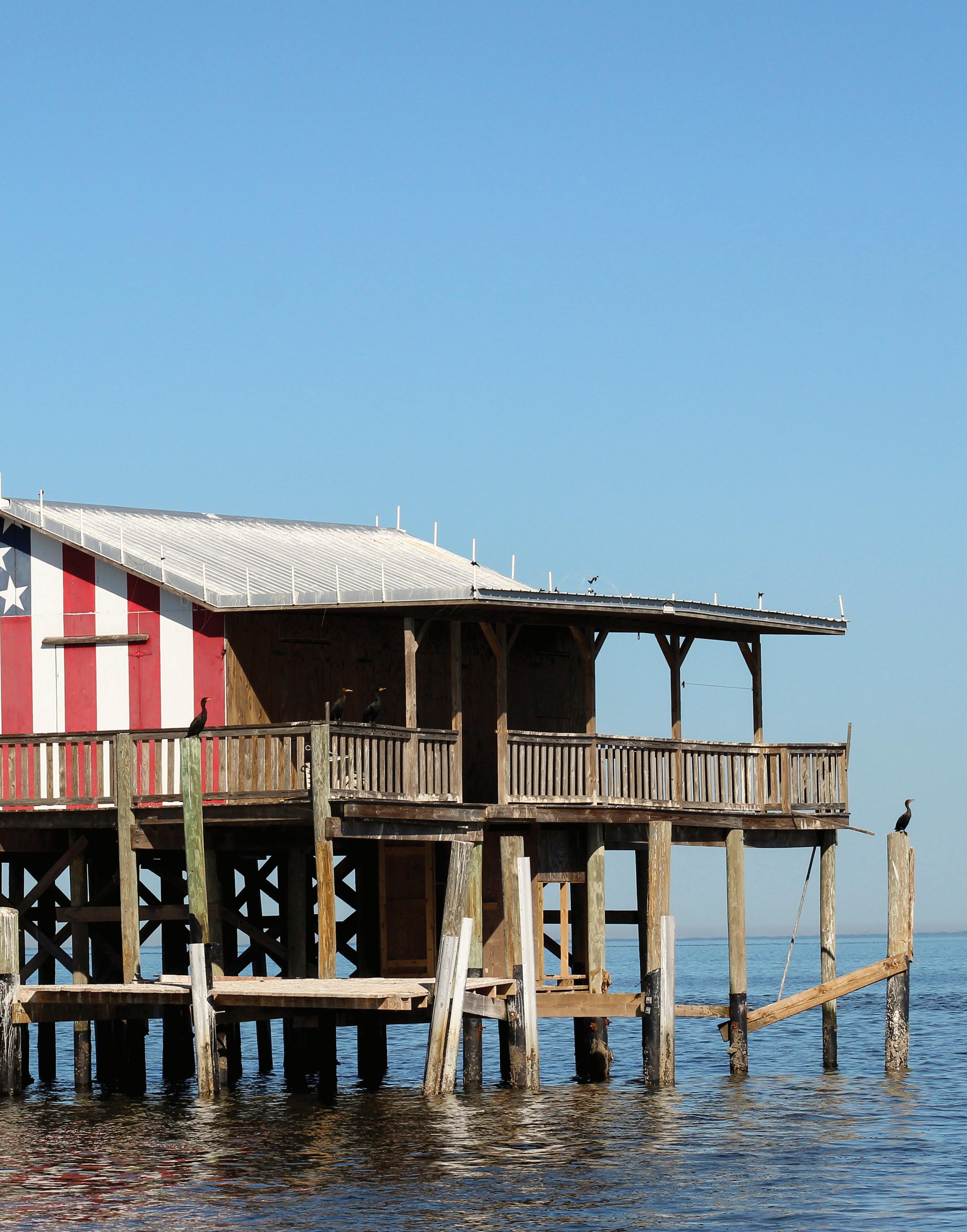
It’s not clear when the stilt houses—then called fish camps— were first built over the water in Pasco County, but local historian Jeff Miller estimated they first appeared between 1916 and 1918. Jeff, who died in 2022, spoke with stilt house owners who said the early fishermen “found a spot they liked, and built a home,” in his book, “History of Pasco County: Stilt Houses in the Gulf of Mexico.”
With the advent of motorboats, these unique buildings above the Gulf became more common as vacation homes than storage spaces.
“The move from fishing camp designs to family dwellings took off after World War II,” Steve Kornacki wrote in a 2005 Tampa Tribune article titled “Houses Built for Fishing.” “The Allgood, Baillie, Bennett, Grey, Haines, Helms, Jones, Little, Sawyer, Stevenson, Swartsel, Thiel and Warburton families were among those building about that time.”
Over time, the number of stilt houses grew. By the 1960s, about 24 dotted the waters off the coast of Pasco County, serving both as fishing spots and vacation retreats. Country music legend Johnny Cash and his wife, June Carter, visited the area often. June’s family long had a bungalow off the Cotee River, and the couple once fished off the stilt house of good friend and


Florida resident Des Little. On one occasion, the couple also enjoyed the waters with the Rev. Billy Graham.
In 1962, Ralph Bellwood described life on the stilt houses in his book “Tales of West Pasco.”
“In the summer particularly, they are occupied on weekends, holidays and vacations,” he wrote. “They are delightfully cool and offer relaxation and peace to their occupants. One can always catch a mess of pan-fish for supper from the deck or get in their boats and cast about over the flats, bringing in trout and other larger fish. Truly, these unusual cabins on the water offer a retreat to the tired and weary as well as the fun-seeking carefree who want to let their hair down, and more or less go native.”
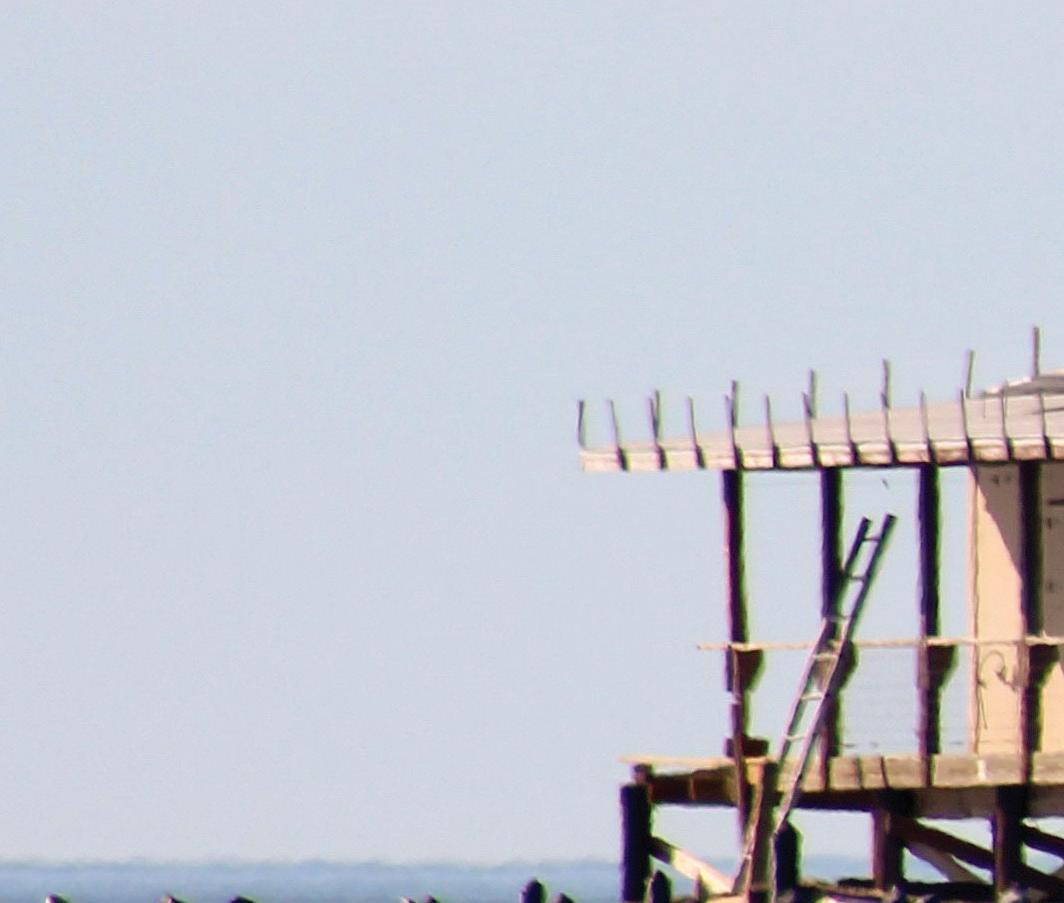

“Native” it was—and still is. A visit to a stilt house is not all that different from primitive camping.
Bathrooms must be set apart from the main structure and not connected to Gulf waters, so waste disposal is akin to a bilge on a boat or an RV. In other words, wrap it up and take it with you. There’s no electricity unless a generator is hauled in, and cooking usually involves a propane stove. Best leave the cellphone at home.






Ruth Carley described a stilt house owned by the Allgood family in a 1973 article for the St. Petersburg Times. The family built the “home on water” in 1949. It was used for vacations with family and friends.
The house featured a large room with beds at one end to catch the cross-breeze and two couches at the other end. The kitchen had an old-fashioned water pump, and in the center was the “congregating place” with a table big enough for 25 people. A shelf around the wall and a platform on the rafters provided storage.
Anita Kilpatrick, writing for the St. Petersburg Times in 1986, quoted stilt house owner and Leesburg resident Dale Jones, who used his camp to get away from working life.
“It’s just a relaxing place,” Dale says in the article. “We can forget about the telephone, and we can forget about television. We can forget about business.”



Basically, these were just little houses where people could stay and fish, Mark explains as he rounds the first of nine houses that remain today. “They were handed down over the generations and are still in use now,” he says.
For a while, at least.
After Hurricane Gladys destroyed many of the stilt houses in 1968, the Florida Legislature prohibited building new ones on open water. Those that
remained were “grandfathered in” with a demolish date of 1999, which was later rescinded.
Today, if a hurricane or other natural event damages a property, rebuilding is allowed only if it’s less than 50% restoration. Too much damage, and owners cannot rebuild. For those that have fallen to nature’s fury, only white poles remain in the water.
The remaining stilt houses are mostly constructed of marinegrade lumber, which “holds up pretty well,” Mark says. In the early days, cypress, a wood that can withstand water intrusion, was brought out by boat.
“Now, that’s an absolute no-no,” says Raul Nardi, marketing and communications manager at Florida’s Sports Coast tourism bureau, which includes Port Richey. “The state won’t let you cut down cypress.”
The pilings on which the stilt houses rest are made of wood as well, but one house features added concrete to its foundation and dock.

“That’s a new thing—to put concrete on the poles,” Mark says. “It keeps the barnacles from rotting the poles.”
These unique and historic fish camps won’t last forever. In time, nature will find a way to erase them from the Gulf waters off Port Richey. But until then, they stand as an iconic symbol of Pasco County. To celebrate the town’s 100th anniversary this year, for instance, the city placed one of its beloved stilt houses on the centennial logo.







Garlic and Rosemary Grilled Lamb Chops
2 pounds thick-cut lamb rib chops
4 cloves garlic, minced
1 tablespoon fresh rosemary, chopped
1 tablespoon Dijon mustard
1¼ teaspoon kosher salt
½ teaspoon ground black pepper
Zest of 1 lemon
¼ cup olive oil
Combine the garlic, rosemary, Dijon mustard, salt, pepper, lemon zest and olive oil in a measuring cup.
Pour the marinade over the lamb chops, flipping them over to cover completely. Cover and marinate the chops in the refrigerator for at least one hour or up to as long as overnight.
Let the lamb chops come to room temperature before grilling.
Grill the lamb chops on medium heat for 7 to 10 minutes or until the internal temperature reads 135 F.
Allow the lamb chops to rest on a plate covered with aluminum foil for 5 minutes before serving.

2 pounds fresh asparagus
2 tablespoons olive oil
¼ teaspoon freshly ground black pepper
Heat oven to 400 F.
½ teaspoon kosher salt
½ cup freshly grated Parmesan cheese
2 lemons, cut in wedges
If the stalks of the asparagus are thick, peel the bottom half of each. Lay them in a single layer on a sheet pan spread with aluminum foil. Drizzle with olive oil. Sprinkle with pepper and salt.
Roast until tender, about 15 to 20 minutes. Sprinkle with Parmesan cheese, and return to the oven for another minute. Serve with lemon wedges.
2 pounds Yukon gold potatoes, peeled and cut into chunks
Salt
¼ cup heavy cream
4 tablespoons unsalted butter, divided
¼ teaspoon nutmeg
½ teaspoon black pepper
3 large egg yolks
Place potatoes in a medium to large pot, and cover with a few inches of cold water. Add a few teaspoons of salt to the water. Bring to a simmer. Cook until the potatoes are forktender, about 20 to 25 minutes.
While the potatoes are boiling, melt 2 tablespoons of butter, and set aside. You will use this butter to coat the potatoes right before they go into the oven.
Heat the oven to 425 F.
When the potatoes are cooked, drain in a colander. Put the potatoes back in the pot, and set over low heat. Allow them to release steam for a minute or two.
Add 2 tablespoons of butter, and mash the potatoes until the butter has been incorporated. Add the nutmeg, black pepper and heavy cream. Continue mashing the potatoes. Once everything is incorporated, add salt to taste. Add the egg yolks. Continue to mash until the mixture is smooth. Do not over-mash, or your potatoes will end up with a gluey consistency.
Put the mashed potatoes in a piping bag with a large star point. Pipe the potatoes onto a cookie sheet. Brush the swirled edges with melted butter so they brown nicely in the oven.
Bake until nicely browned, about 20 minutes. Serve hot from the oven.
Salad
10-ounce bag baby spinach leaves, rinsed and drained
½ cup walnut pieces
½ cup crumbled feta
Vinaigrette
¼ cup aged balsamic vinegar
¼ cup extra-virgin olive oil
2 to 3 tablespoons honey
¼ medium red onion, sliced thin
¼ cup alfalfa sprouts
½ cup pomegranate seeds
2 teaspoons Dijon mustard
½ teaspoon dried thyme
1 clove garlic, minced
Salt and pepper
Combine all vinaigrette ingredients. Shake well.
Place spinach in a salad bowl. Top with walnuts, feta, red onion, alfalfa sprouts and pomegranate seeds. Drizzle with vinaigrette.
1 package yellow cake mix
3.4-ounce package instant pistachio pudding mix
Icing
3.4-ounce package instant pistachio pudding mix
1 cup cold heavy whipping cream
¾ cup cold whole milk
Heat oven to 350 F.
4 large eggs
1 cup club soda
½ cup canola oil
2 teaspoons confectioners’ sugar
½ cup chopped walnuts for garnish
In a large bowl, combine the cake mix, pudding mix, eggs, soda and oil. Beat on low speed for 30 seconds. Beat on medium for 2 minutes.
Pour into a greased and floured 10-inch fluted tube pan. Bake for 40 to 45 minutes or until a toothpick inserted in the center comes out clean. Cool for 10 minutes before removing from the pan to a wire rack to cool completely.
To make the frosting, beat the pudding mix, cream, milk, and confectioners’ sugar on high in a large bowl until stiff peaks form. Frost cake. Sprinkle with walnuts. Refrigerate until serving.
Story and photo by Dave LaBelle
As a small child, I was spellbound by giant rainbows stretching across the valley near our home. The magnificent bands of glistening colors felt so close I could almost touch them, bathe in them. Believing there was a pot of gold buried where each end of the rainbow touched the earth, my siblings and I sometimes raced barefoot across the fields hoping to find the treasure before the magical bow disappeared.
I’m not sure at what age I outgrew the legend of hidden treasure. Perhaps it was the same time I began questioning the Easter Bunny?
Sadly, as I grew older and wiser, the awe I once had for those fading, magical colors also disappeared. As a teenager, rainbows no longer held the same allure.
But then, not long after my mother disappeared in floodwaters and our home was washed away by endless days and nights of torrential rains, I was reading in the book of Genesis how God set a bow in the sky after the great flood as a sign the Earth would never again be destroyed by water. As you can imagine, the story stirred my heart, and I have never viewed a rainbow the same since. And soon that mystery—that childhood wonder—even returned.
I believe rainbows will forever capture our imagination.
Whether you believe the Bible story or are simply touched by those colorful, curved ribbons of light stretching across the sky or magically appearing in the mist above a lake or river, there is something beautifully comforting and hopeful about seeing a rainbow appear.

Photographer, author and lecturer Dave LaBelle has captured special moments for more than half a century, sharing photo tips and life perspectives with readers. For more of his writings, visit davidlabelle.com and his blog at bridgesandangels.wordpress.com.
NIKON D810 70mm lens ISO: 125 f/5 at 1/640

Including an interesting foreground creates scale, depth and dimension. A vibrant rainbow can be the star of your photograph or an unexpected accent to complement an already colorful scene, such as pitcher Max Steffens, of Epworth, Iowa, competing in a semipro baseball tournament.
Keep your camera close and be ready as storms clear and rains cease. Often after a rainy day, clouds part before a sunset, and a rainbow alone can be a breathtaking sight.
Email your best image (just one, please) with caption information, including an explanation of how it affects you, to gph@pioneer.coop. We may share submissions on our website and social media channels.





















Most Florida anglers probably started fishing as children by dangling worms or crickets under floats to catch bluegills and other bream species. This old method will always work, but for more of a challenge, try casting lures for small scrappers.
Among the most versatile lures on the market, spinnerbaits catch fish from top to bottom all year long and can go many places where other lures can’t go. Many bream anglers throw small “beetle” spinners, also called “harness” or “jighead” spinners.
Such baits consist of a wire harness holding a spinner blade attached to a jighead. Anglers can slip an infinite number of small soft-plastic trailers onto the hook. Since the components separate, anglers can easily switch blades, arm sizes, jigheads or trailers as they wish. For added enticement, tip the hook with a colorful scent pellet.
A beetle spinner can catch bream from the surface to the bottom. Retrieval speeds determine how deep the lure runs. Simply toss the lure to grassy edges, lily pads, logs, or other cover that might hold fish and work it back to the boat.
Around thick grassy patches, buzz beetles over the top so the blades churn the water or wake the baits just below the surface. The commotion might bring fish up from the depths. Around submerged grass, run the bait just over the blade tops. Occasionally, pause so the lure sinks a bit into the grass. Then, pull it back up.
Bluegills and other bream species live in just about every freshwater system in the Sunshine State. Bluegills spawn from spring through early fall. They scour beds in the bottom and vigorously defend their nests. Run a beetle through the nests for hot action.
As weather warms, fish might head a little deeper for more comfortable temperatures. In deeper water, barely turn the reel handle, just enough to make the blades flicker. Run the lure just above the bottom. Also try the stop-and-drop method. Pause the retrieve periodically to let the bait sink 1 or 2 feet. As the bait slowly sinks into the water, the blades continue revolving, creating flash and vibrations. Fish commonly hit lures as they sink.
Sloping banks and drop-offs make great places to fish. Bream can move up and down in the water column as they desire. Bream commonly hover just over the drop-off edges looking to ambush passing prey. Run a spinner on the deep side of the drop-off parallel to the edge.
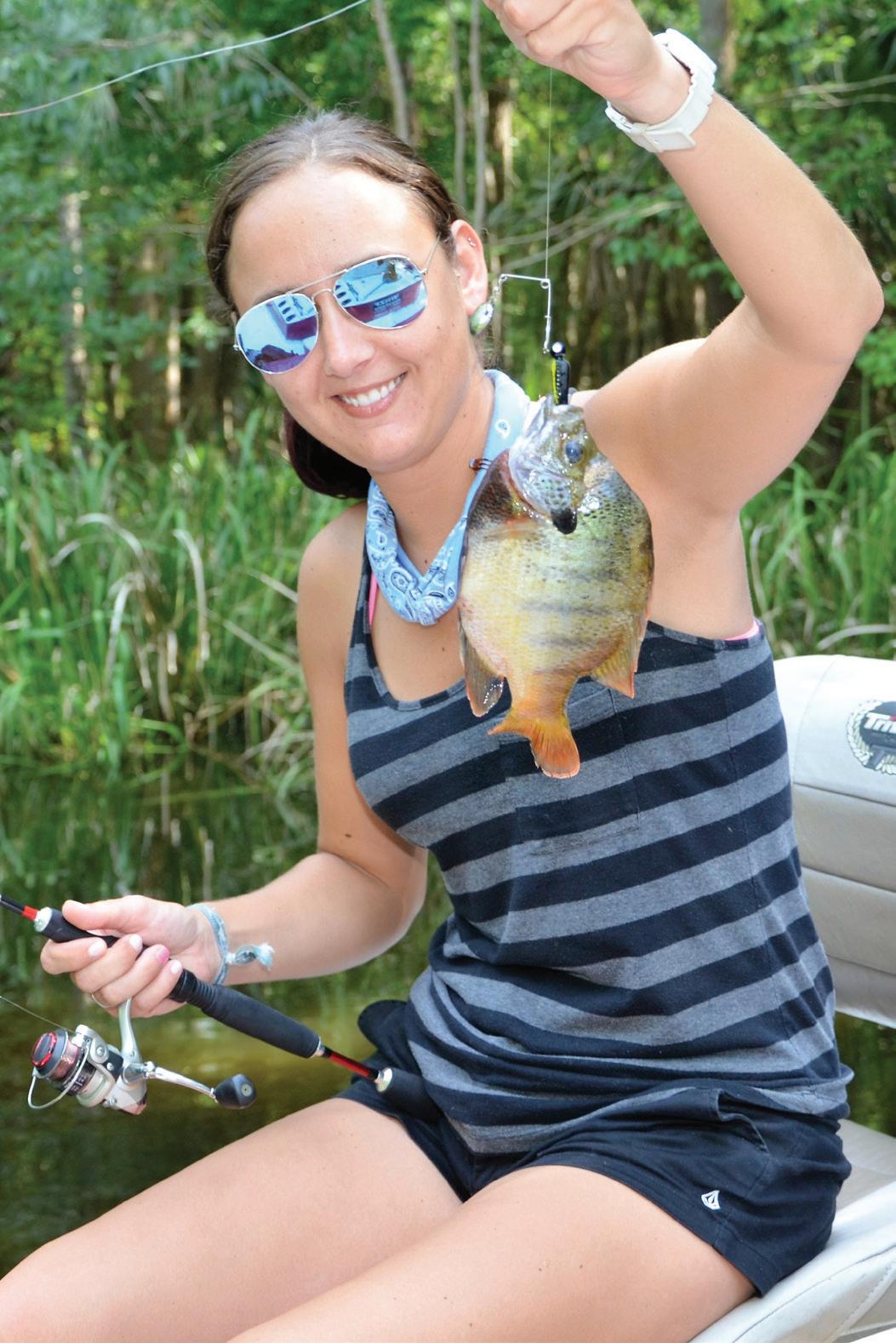
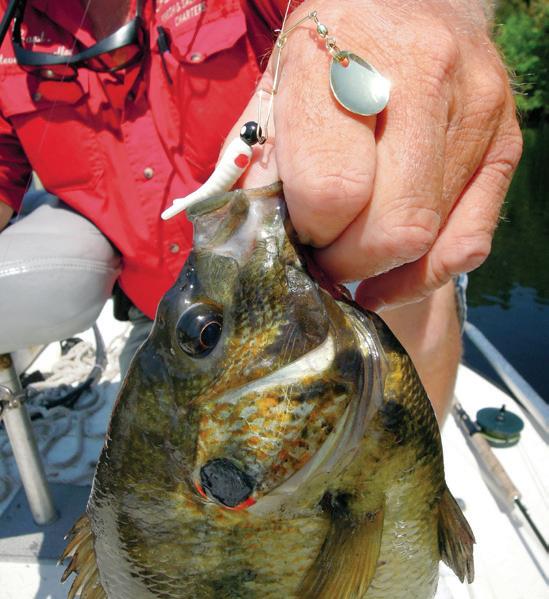
ABOVE: Amy Gable shows off a bluegill she caught on a beetle spinner while fishing a backwater off Dead Lake near Bunnell.
LEFT: A beetle spinner makes a great bait for tempting panfish, such as this redear sunfish, also called a shellcracker for its fondness for eating snails.
PHOTOS COURTESY OF JOHN N. FELSHER
As we progress into summer, fish regularly seek shelter under docks, trees, bridges and other features that cast shadows on the water. Any shady spot makes a great place to throw a beetle spinner.
Easy to master and inexpensive, fishing with small beetle spinners on ultralight tackle offers an excellent and fun way to introduce children or novice anglers to the sport. In the right spot, anybody could catch good numbers of feisty fish. Although small, bluegills and other bream species will outfight anything in the water, ounce for ounce. n

John N. Felsher is a freelance writer, broadcaster, photographer and editor. An avid sportsman, he’s written more than 3,500 articles for more than 170 different magazines on a wide variety of outdoor topics. He also hosts an outdoor tips show for WAVH-FM Talk 106.5 in Mobile, Alabama. Contact him at j.felsher@hotmail.com or through Facebook.


Centuries ago, Persians, Tibetans and Mayans considered turquoise a gemstone of the heavens, believing the striking blue stones were sacred pieces of sky. Today, the rarest and most valuable turquoise is found in the American Southwest–– but the future of the blue beauty is unclear.
On a recent trip to Tucson, we spoke with fourth generation turquoise traders who explained that less than five percent of turquoise mined worldwide can be set into jewelry and only about twenty mines in the Southwest supply gem-quality turquoise. Once a thriving industry, many Southwest mines have run dry and are now closed.
We found a limited supply of turquoise from Arizona and purchased it for our Sedona Turquoise Collection . Inspired by the work of those ancient craftsmen and designed to showcase the exceptional blue stone, each stabilized vibrant cabochon features a unique, one-of-a-kind matrix surrounded in Bali metalwork. You could drop over $1,200 on a turquoise pendant, or you could secure 26 carats of genuine Arizona turquoise for just $99.
Your satisfaction is 100% guaranteed. If you aren’t completely happy with your purchase, send it back within 30 days for a complete refund of the item price.
The supply of Arizona turquoise is limited, don’t miss your chance to own the Southwest’s brilliant blue treasure. Call today!
Jewelry Specifications:
• Arizona turquoise • Silver-finished settings
Sedona Turquoise Collection
A. Pendant (26 cts) $299 * $99 +s&p Save $200
B. 18" Bali Naga woven sterling silver chain $149 +s&p
C. 1 1/2" Earrings (10 ctw) $299 * $99 +s&p Save $200
Set
**Complete set includes pendant, chain and earrings.



All ages can find something new and exciting around every corner of the state. Filled with rich history, abundant natural beauty and diverse events all year, Florida has something fun for everyone.
April 5
Palafox Market


Find unique, precious, delicious and offbeat items at Palafox Market. On-site vendors grow, make or create each item for sale. Join us 9 a.m. to 2 p.m. every Saturday, rain or shine, for farm-fresh produce, plants, flowers, baked goods, hand-crafted works of art, sculpture, fresh tea and coffee, food and spices, hand-blown glass, ceramics and more at the event named Florida’s Best Farmers Market by Southern Living magazine. https://downtownpensacola.com/palafox/palafox-market; 850-380-8196
April 5-6
Sebring Soda Festival
Float over to the seventh annual Sebring Soda Festival for a family-friendly party atmosphere that offers more than 200 craft sodas to sample, craft beer and wine, and soda drinking contests. With Soda Pop Princess skits, live music and festive food, this is the fizziest festival in all of Florida. https://sebringsodafest.com; 863-385-8448
April 11
Outdoor Movie Night
Join us at dusk for a free outdoor movie night at Fort East Martello. Enjoy food from our vendors, including fresh-squeezed lemonade, frozen treats and all your favorite snacks. Don’t forget the free popcorn, courtesy of First State Bank of the Florida Keys, which benefits the Key West High School. Invite your friends, bring your blankets and chairs, and let’s make this outdoor movie night one for the books. https://bit.ly/3DjUTrn; 305-814-2789
April 12
Deluna’s Open Water Swim 2025


Join us on Pensacola Beach for the annual DeLuna’s Open Water Swim. Pick the 0.6-, 1.2- or 2.4-mile swims to challenge your skill and speed in clean protected waters in the Santa Rosa Sound. As legend has it, Don Tristan de Luna—a 16th-century Spanish conquistador who led an ill-fated expedition to the Pensacola area in 1559—is credited for America’s first settlement. A scroll of de Luna’s was recently discovered in the sand of Pensacola Beach outlining a competitive open water swim they were planning. Unfortunately, a hurricane changed the course of Pensacola’s history, wiping out the settlement, thus never allowing the swim to take place. Our event is an effort to continue what de Luna started.
www.pensacolasports.org/delunasswim; 850-434-2800
April 12
Full Moon Yoga
Meditate and relax under the glow of the full moon on Sunrise Point at Three Waters Resort and Marina. Zenfully Aware Yoga, the Islamorada Resort Collection, and I.CARE bring participants on an adventure. The yoga practice centers around how the moon affects coral reefs, queuing coral spawning each year and the start of a new life for one of our planet’s most precious ecosystems. The class is complimentary for resort guests, but a donation is suggested for I.CARE, which is dedicated to restoring the reefs of Islamorada, including the world-famous Alligator Reef. Admission for nonguests is $25 per ticket.


April 5-6
33rd Annual Florida Keys Island Fest
The 33rd Annual Island Fest event returns to Founders Park (MM 87), featuring an art show, live music, food and classic cars. The Arts and Crafts Show showcases artists whose works include paintings, sculptures, jewelry, fine crafts and driftwood carvings. The Smoked Fish Dip Contest returns by popular demand. Also returning this year is the All-American Road Vintage Cruisers Car Show. Children and adults can help paint a life-sized dolphin statue and compete in HulaHoop contests while giant kites fly high in the sky. Admission is free, and on-site parking is $5. The Islamorada Chamber of Commerce encourages the public to “Keep the Scene Green” and bring reusable drink containers to reduce plastic use during the event.
https://islamoradachamber.com/island-fest; 305-664-4503

https://bit.ly/3Fk3F9m; 844-918-0516







April 12
Swim Across America
Join Swim Across America for the fourth annual Florida Keys open water charity swim from 8 a.m. to noon at the beautiful Founders Park. The halfmile, 1-mile and 2-mile swims will be available. A children’s splash will be offered, and several Olympians will attend as angel swimmers for those who may want a little help. Proceeds support cancer research at Miami Cancer Institute. www.swimacrossamerica.org/floridakeys; 949-292-7897
April 19
Earth Day 5K Run/Walk


Join us at 8 a.m. for the 26th annual Earth Day 5K Run/Walk. The event benefits the Conch Republic Marine Army, an organization working on cleaning and restoring the mangrove habitats of the Florida Keys. The run begins and ends near the Ingham ship, following three loops of the promenade at Truman Waterfront Park. Awards are given for age-group winners. All participants are entered into a raffle for local prizes. T-shirts are available to the first 100 participants. https://southernmostrunners.com; 619-961-3017
April 19
Music in the Park
Join the Friends of Highlands Hammock State Park at 7 p.m. for rocking rhythm and blues by J.P. Soars and The Red Hots. Bring blankets, lawn chairs and flashlights to enjoy an evening of music under the stars. Don’t forget the mosquito spray on warmer evenings. Refreshments and food will be available for purchase from an on-site food truck and the Hammock Inn Camp Store. Admission for all concerts is $15 per adult—campers and dayto-day visitors. Accompanied children 12 years and younger get in free of charge. Pets are not permitted. https://friendsofhighlandshammockstatepark.wildapricot.org; 863-386-6094


April 19
Keys Community Concert Band
Bring a chair or spread out a blanket as the band performs Conch Classics, featuring music from throughout the ages. The concert starts at 4 p.m. at the ICE Amphitheater at Founders Park (MM 87). Admission is free. keyscommunityconcertband.org; 305-394-1123
April 26
Blueberry Festival
Join the Avon Park Rotary Club for the 14th annual Avon Park Blueberry Festival. This free and family-friendly event features original arts and craft vendors, live bluegrass entertainment, a cornhole tournament, a kids’ zone, car cruise-in, food trucks and more. Don’t miss the Amateur Blueberry Bake-Off. Winners for youth and adult divisions will be announced during the festival with monetary prizes for the top three finishers in each division. It’s free to enter the competition.

https://bit.ly/41TNsQP; 863-414-1733



April 5
Annual Spring Fling

The Crafty Cats at First United Methodist Church have been busy. You are invited from 9 a.m. to 2 p.m. to shop for plants, yard ornaments, garden decor, decorated pots and seasonal crafts. Hot dogs, fresh off the grill, will be available for $5. Chips and a drink are included in the price.
fumclw.org; 863-676-2516
April 30-May 1
Jeff Leonia Reel and Steel Classic
The tournament kicks off at 6 p.m. April 30 at Safe Harbor Angler House. The grouper/hogfish tournament starts at 7 a.m. May 1 and has categories for men and women in scuba, free dive and rod/reel in memory of Jeff Leonia. A fun category for snapper is also included in the event. Registration is $150. Children 12 and younger fish for free. Proceeds stay in the Keys, supporting local endeavors. www.livelikejeff.com; 919-414-4300


Want to share a family-friendly event with the readers of Florida Currents? Head online and enter the details at tinyurl.com/FloridaCurrents or use the QR Code for easy access. Make sure to submit the item at least 60 days before the event (due to press deadline). If you own rights to a print-quality photo promoting your event, include it with photo credit information.







When you’re looking to lower your water bill, you might be wondering the best way to maximize your water savings.
If you have an in-ground irrigation system for your lawn, this is a great place to start. Research shows that for homes with an in-ground irrigation system, outdoor water use can be the biggest reason for high water bills. Every time the average-sized yard in Florida is watered, it uses at least 1,000 gallons of water, according to University of Florida research. You would have to take a shower for more than eight hours to use that much water.
To save water used on your landscape, start by looking at how frequently you water your property.
Your irrigation timer should be set to water no more than twice a week. In the winter, your lawn goes dormant and won’t need water more than once a week. However, the best method is shutting off your automatic irrigation system and turning it on only when needed.
Signs your lawn needs water include your footprints staying in the grass for a long time or leaf blades being folded in half lengthwise. By not overwatering your yard, you also increase drought resistance and reduce pests and fungal problems.
You can prevent wasting large amounts of water by stopping leaks quickly. Turn on your irrigation system seasonally to check for puddles of water and broken sprinkler heads. Check your sprinkler heads to make sure they’re not watering your sidewalk or driveway. They may even be turned the wrong way, missing your yard completely.
Also, check that you have a working rain sensor device to make sure you’re not irrigating when rain has already done the job.

Finally, most established plants don’t need to be watered regularly, and you likely can turn off those irrigation zones.
To easily save water, design a yard that doesn’t need much water to begin with. You can use mulch, choose drought-tolerant plants and plant landscaped beds instead of grass.
Plants with similar water needs should be grouped together to make it easier to get them the right amount of water. The FloridaFriendly Landscaping program is a great resource for making sure you have the right plant for the right place.
Once you’ve tackled your outdoor water use, begin looking for ways to maximize savings indoors.
For some homes, the toilet could be the best way to save water. A small toilet leak could add up to hundreds of gallons of water, and older toilets can use more gallons per flush than newer ones.
Other ways to save water include low-flow shower heads that can cut your shower water use in half. Faucet aerators can do the same for your sinks.
Beyond reducing your utility bill, saving water helps protect springs and valuable Florida resources for generations to come. For more ways to save water and make your landscape Florida-friendly, reach out to the UF/IFAS Extension office in your county.

Kaitlin Robb Price is a project manager for H2OSAV: Water Savings, Analytics and Verification, a UF/IFAS Extension program focused on measurably saving Florida water. She has a master’s in mass communication from the University of Florida, as well as a B.S. in business administration from Auburn University.






By Anne Prince
As the world continues to progress, so too does the demand for reliable electricity. Data centers, new manufacturing facilities and people’s daily lives are requiring more and more electricity. In fact, U.S. power consumption is expected to rise to record highs this year and next, and the demand for electricity in the states is expected to at least double by 2050.
Meanwhile, the supply of electricity is already decreasing as always-available power plants are being prematurely shut down. The North American Electric Reliability Corporation has warned that 19 states could see rolling blackouts during times of high electrical demand over the next five years. We all know what happens when supply can’t meet demand—prices go up, and the lights go off.
As the cooperative prepares for this rising demand, Glades Electric Cooperative is planning to ensure local families and businesses have access to an affordable, reliable supply of electricity.
Meeting the Challenge
To meet these challenges, Glades Electric—through its wholesale


power provider Seminole Electric Cooperative—is using a balanced mix of always-available energy sources as a safeguard to maintain a reliable energy supply. The cooperative is also investing in innovative technologies to bolster grid resilience and enhance data management to improve operational efficiency, expedite outage response times and minimize service disruptions.
As electricity demand continues to rise, upgrading and building new infrastructure will be critical. That’s why GEC collaborates with other electric co-ops by pooling resources and expertise on projects that advance technology, security, infrastructure and innovative energy sources to meet the increasing needs of its communities.
This collaborative approach is a core strength of Glades Electric and enables the co-op to deliver affordable energy to local families and businesses. GEC’s priority is ensuring energy solutions that are tailored to the unique needs of the community to help it thrive now and in the future.
Eighty years ago, Glades Electric was built by the community it serves, providing essential services that drive growth and pave the way for an energy future that prioritizes reliable electricity at a cost local families and businesses can afford.


Sign up today with Conexon Connect and get a free installation! View the map below to check your availability!





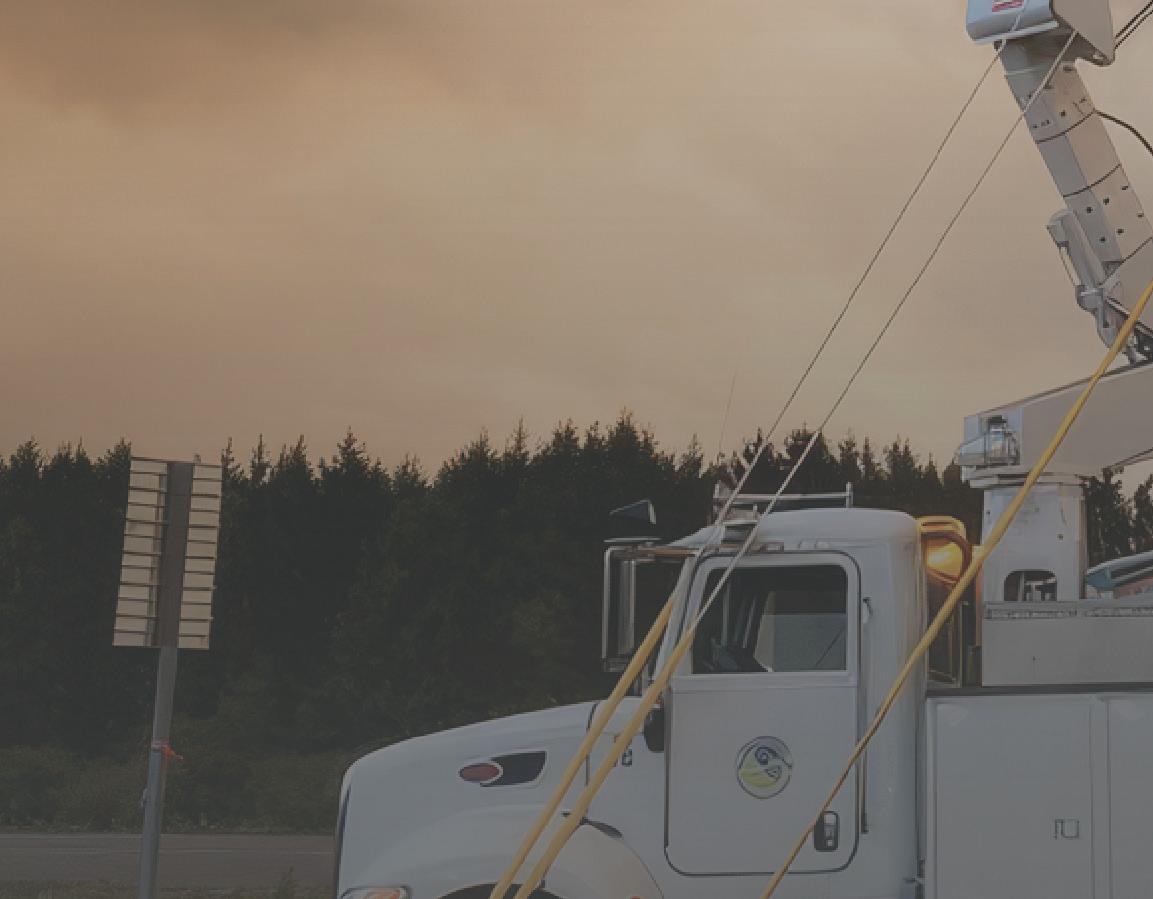
Lineworkers brave ice, re, oods and storms, Thank you doesn’t quite cover it.










Florida’s geography is vast and beautiful, from lakes to oceans and parks to beaches. Some of you have views from your homes that rival the views of national parks.
From time to time, we share some readers’ photos in this space. If we use your photo here, we will send your choice of a $25 gift card to REI or Amazon.
To submit your photo, email a JPEG file to photos@floridacurrents.com. Include “Before You Go” in the subject line. Please share a bit about what inspired you to make your photo.













IguessI was a little bored. For the past hour, I’d been on the phone with Daniele, the head of my office in Italy, reviewing our latest purchases of Italian gold, Murano glass and Italian-made shoes and handbags.
“Daniele,” I said, “What is the hottest jewelry in Italy right now?”
His reply? Woven gold bracelets studded with gems. He texted me some photos and I knew immediately that this was jewelry that Raffinato just had to have.


Presenting the Italiano Fantasia Bracelets, two designs that are prime examples of Italy’s finest artisanship. Each of these bracelets includes more than 20 brilliant cut gems of DiamondAura®, our Ultimate Diamond Alternative®, in a setting finished with 18 karat Italian gold.
What is DiamondAura®? Why, it’s a sparkling marvel that rivals even the finest diamonds (D Flawless) with its transparent color and clarity: Both are so hard they can cut glass. Don’t believe me? The book “Jewelry and Gems: The Buying Guide,” praised the technique used in our diamond alternative: “The best diamond simulation to date, and even some jewelers have mistaken these stones for mined diamonds,” it raved.



The best part about these bracelets? The price. Because of our longstanding connections in Arezzo, the mecca of Italian goldsmithing, we can offer both bracelets together for just $99, a fraction of the price you’ll pay anywhere else for similar jewelry.
Order today. These bracelets are one of our hottest sellers this year, and with disruptions in the supply chain, we can only guarantee that we have 1,273 861 of these bracelets on hand for this ad.
Make the next gift you give your loved one a trip to Italy with the Italiano Fantasia Bracelets, stunning accessories that are sure to turn heads.


Jewelry Specifications:
• Made in Arezzo, Italy. 18k gold finish
• DiamondAura®, the Ultimate Diamond Alternative®
• Fit wrists up to 7 ¼"
Italiano Fantasia Bracelet Collection
A. X Bracelet (¼ ctw) $399 $59* + S&P Save $340
B. Woven Bracelet (⅓ ctw) $299 $59* + S&P Save $240 Set of Both $698 $99* + S&P Save $599
*Special price only for customers using the offer code.





Electric Cooperative, Inc.
“Neighbors Working for Neighbors”
CONTACT US
855-940-3810
www.gladeselectric.com
7 a.m. to 6 p.m. Monday through Thursday
26733 U.S. Hwy. 27
P.O. Box 519
Moore Haven, FL 33471
214 SR 70 W. Lake Placid, FL 33852
REPORT AN OUTAGE
Via the SmartHub app ~ 855-940-3810 (24/7 outage reporting)
Please have your account number ready.
BOARD OF TRUSTEES
Lee Henderson, President, District 6 Highlands Park, 863-633-9281
Barney Goodman, Vice President, District 2 Hendry County, 561-414-8737
Shannon Hall, Secretary/Treasurer, District 4 Lakeport and Brighton, 863-946-3242
Donnie Lundy, Trustee, District 1 Moore Haven, 863-634-7314
Mike Pressley, Trustee, District 3 Ortona and Palmdale, 863-673-9158
Brad Oxer, Trustee, District 5 Venus and Hicoria, 863-441-1866
Fred Tagtmeier, Trustee, District 7 Lorida, 863-214-4994
Vicki Pontius, Trustee, District 8 Lake Josephine, 863-414-2917
Angela Hodges, Trustee, District 9 Okeechobee, 863-801-3140
The Board’s next meeting is at 9 a.m. April 24 at Moore Haven Headquarters Office. Any changes are posted in the lobby of both district offices.
EXECUTIVE STAFF
Jeff Brewington, CEO
Renee Bass, Chief Administrative Officer
Courtney Brown, Chief Personnel Officer
Jennifer Koukos, Chief Communications Officer
Jennifer Manning, Chief Financial Officer
Michael Roberge, COO and Assistant General Manager
It’s that time of year when we annually pay tribute to our lineworkers. As you can see, much of this month’s publication is focused on them and their specialized work. The attention is warranted.
Can you imagine a job that has you staring death in the face every day? It takes a team to make sure we work safely and go home to our families alive and sound every day. I’m grateful to report that our team has now worked 939 days with no lost time accidents.
Are you ready for the cooperative’s 80th anniversary Annual Meeting? I am, and my vote has been cast through the easy-touse SmartHub app. Hopefully, your vote is already in, and you’re entered for your chance to win one of five $1,000 bill credits.
You can view a recording of the meeting April 10 on our Facebook page, the 2025 Annual Meeting webpage or the Glades Electric Cooperative YouTube channel for all the results and to see how you fared in the prize drawing. I’m already thinking about next year’s event and encouraging more participation with 10 $500 bill credits. Stay tuned.
At last year’s event, we reported 558 members were connected to genuine, high-speed internet through the cooperative’s partnership with Conexon Connect. You’ve continued to show your demand for this product. As of mid-March, there are now 1,981 cooperative members connected, with nearly 2,000 more in the installation queue.
We are pleased to report that the project is coming to completion sooner than originally projected. The entire membership may have access by the end of the year. You asked for it, and you got it!
I dare say at our 90th Annual Meeting we’ll probably think this service is just as critical as electric energy service, but also take it for granted as we do electricity. The cost of either endeavor is soon forgotten.
Be sure to check one of our online channels mentioned above on April 10 to view the results of your 80th Annual Meeting and see the democratic member control of your cooperative in action.

